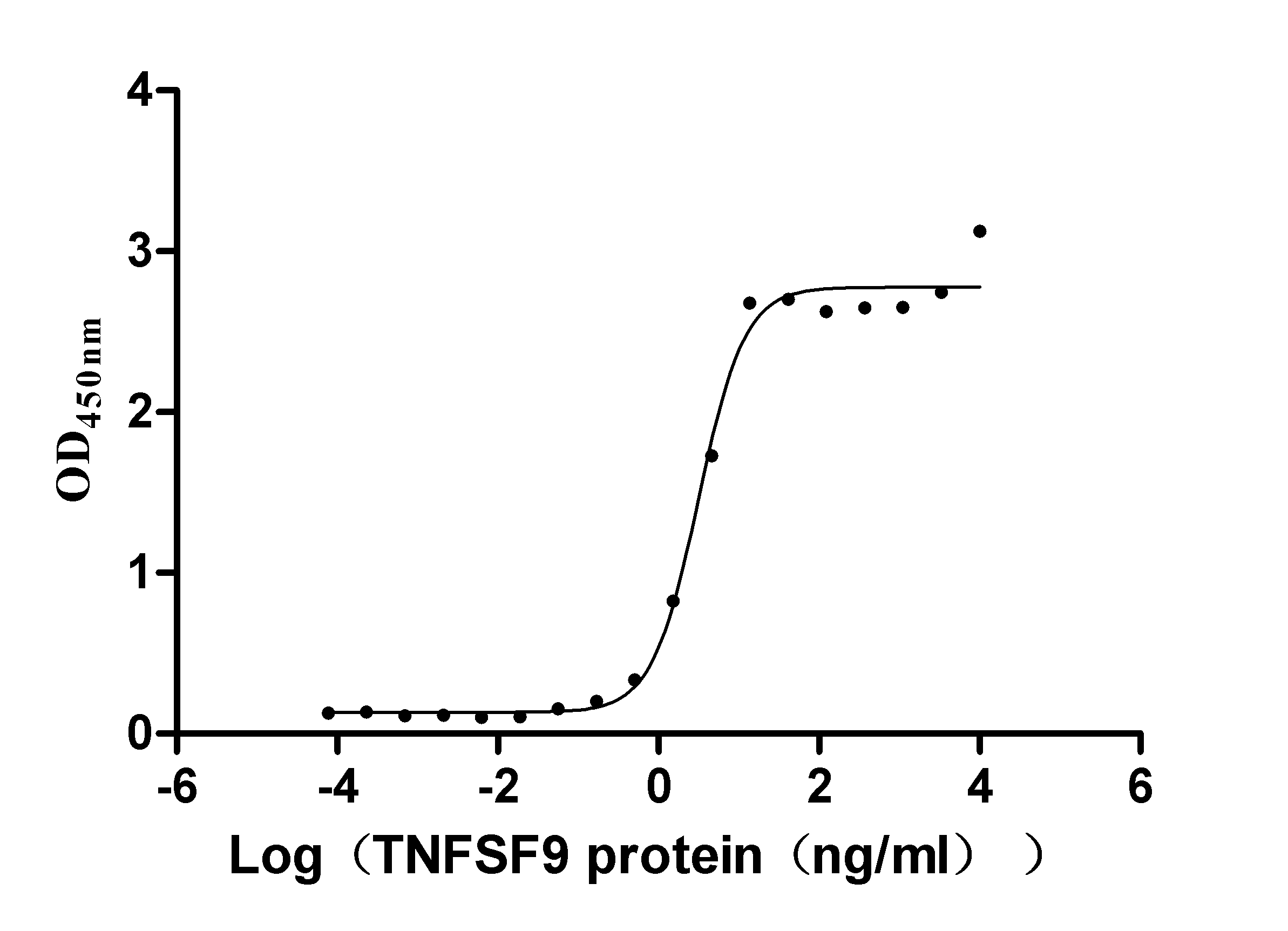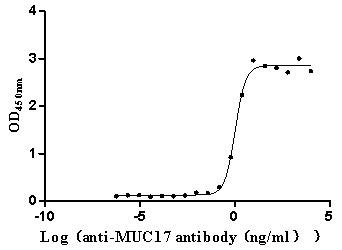Recombinant Human Neurotrophin-3 (NTF3)
-
货号:CSB-YP016120HU
-
规格:
-
来源:Yeast
-
其他:
-
货号:CSB-EP016120HU-B
-
规格:
-
来源:E.coli
-
共轭:Avi-tag Biotinylated
E. coli biotin ligase (BirA) is highly specific in covalently attaching biotin to the 15 amino acid AviTag peptide. This recombinant protein was biotinylated in vivo by AviTag-BirA technology, which method is BriA catalyzes amide linkage between the biotin and the specific lysine of the AviTag.
-
其他:
产品详情
-
纯度:>85% (SDS-PAGE)
-
基因名:
-
Uniprot No.:
-
别名:HDNF; MGC129711; Nerve growth factor 2; Neurotrophic factor; Neurotrophin 3 precursor; Neurotrophin-3; Neurotrophin3; NGF 2; NGF-2; NGF2; NT 3; NT-3; NT3; NTF 3; NTF3; NTF3_HUMAN
-
种属:Homo sapiens (Human)
-
蛋白长度:Full Length of Mature Protein
-
表达区域:139-257
-
氨基酸序列YA EHKSHRGEYS VCDSESLWVT DKSSAIDIRG HQVTVLGEIK TGNSPVKQYF YETRCKEARP VKNGCRGIDD KHWNSQCKTS QTYVRALTSE NNKLVGWRWI RIDTSCVCAL SRKIGRT
-
蛋白标签:Tag type will be determined during the manufacturing process.
The tag type will be determined during production process. If you have specified tag type, please tell us and we will develop the specified tag preferentially. -
产品提供形式:Lyophilized powder
Note: We will preferentially ship the format that we have in stock, however, if you have any special requirement for the format, please remark your requirement when placing the order, we will prepare according to your demand. -
复溶:We recommend that this vial be briefly centrifuged prior to opening to bring the contents to the bottom. Please reconstitute protein in deionized sterile water to a concentration of 0.1-1.0 mg/mL.We recommend to add 5-50% of glycerol (final concentration) and aliquot for long-term storage at -20℃/-80℃. Our default final concentration of glycerol is 50%. Customers could use it as reference.
-
储存条件:Store at -20°C/-80°C upon receipt, aliquoting is necessary for mutiple use. Avoid repeated freeze-thaw cycles.
-
保质期:The shelf life is related to many factors, storage state, buffer ingredients, storage temperature and the stability of the protein itself.
Generally, the shelf life of liquid form is 6 months at -20°C/-80°C. The shelf life of lyophilized form is 12 months at -20°C/-80°C. -
货期:Delivery time may differ from different purchasing way or location, please kindly consult your local distributors for specific delivery time.Note: All of our proteins are default shipped with normal blue ice packs, if you request to ship with dry ice, please communicate with us in advance and extra fees will be charged.
-
注意事项:Repeated freezing and thawing is not recommended. Store working aliquots at 4°C for up to one week.
-
Datasheet :Please contact us to get it.
相关产品
靶点详情
-
功能:Seems to promote the survival of visceral and proprioceptive sensory neurons.
-
基因功能参考文献:
- NTF3 is a novel target gene of POU3F2 and that the POU3F2/NTF3 pathway plays a role in the process of neuronal differentiation. PMID: 29549646
- brain-derived neurotrophic factor (BDNF) and neurotrophin 3 (NT3) levels in post-mortem brain tissue from patients with depression compared to healthy individuals - a proof of concept study PMID: 29102768
- NT-3 has been shown to be both an osteogenic and angiogenic factor, and can also enhance expression of the key osteogenic factor, BMP-2, as well as the major angiogenic factor, VEGF, to promote bone formation, vascularization, and bone healing PMID: 28370021
- High expression of NT-3 is associated with glioblastoma. PMID: 28402394
- Meta-analysis found the levels of both NT-3 and NT-4/5 were significantly increased in bipolar disorder patients. Through subgroup analysis, this increase persisted only in patients in depressed state, but not in manic or euthymic state. In addition, we found the differences in NT-3 and NT-4/5 were significantly associated with the duration of illness, but not by the mean age or female proportion. PMID: 27214525
- NT3 upregulates cellular proliferation, extracellular matrix protein production, and collagen deposition in human aortic valve interstitial cells through the Trk-Akt-cyclin D1 cascade. PMID: 28356268
- The analysis of covariance (ANCOVA) indicated that the mean serum GDNF and NTF3 levels of ADHD patients were significantly higher than that of controls. However, serum BDNF and NGF levels did not show any significant differences between groups. These results suggest that elevated serum GDNF and NTF3 levels may be related to ADHD in children. PMID: 27561780
- There were no differences in neurotrophin levels between patients with schizophrenia and controls. We found lower BDNF and higher NT-3 serum levels in depressed patients with schizophrenia. PMID: 26548545
- The results suggest a gene dose-association between the A allele of rs6332 and the onset of AD in varepsilon4 non-carriers and the NTF-3 rs6489630 polymorphism being a relevant risk factor for AD in patients lacking the ApoE-varepsilon4 allele in this Chinese sample. PMID: 26814132
- Survival, differentiation, and neuroprotective mechanisms of human stem cells complexed with neurotrophin-3-releasing pharmacologically active microcarriers in an ex vivo model of Parkinson's disease. PMID: 25925835
- No differences in plasma BDNF, NGF, NT3, NT4 and GDNF were found between autism spectrum disorders and control. PMID: 25275256
- NT-3 expression was found in axons of olfactory bulb. PMID: 24288162
- genetic variation in the NTF3 gene is related to susceptibility to emotional side effects in response to methylphenidate treatment in Korean children with ADHD. PMID: 23471121
- NT-3 appears to promote growth of metastatic breast cancer cells in the brain PMID: 23001042
- NT-3 promoted motility, migration, invasion, soft-agar colony growth and cytoskeleton restructuring in TrkC-expressing U2OS cells PMID: 23027130
- There was no association between the presence of rs11063714 and curve progression in adolescent idiopathic scoliosis in a 2117-person Japanese cohort. PMID: 23038618
- Results suggested that an NT-3 polymorphism, rs6332, may significantly influence executive function, reflecting interference performances among patients with mild-stage AD. PMID: 23075484
- These findings suggest that NT-3, BDNF, LIF and their combinations predominantly support different ontogenetic events at different developmental stages in the innervation of the inner ear. PMID: 23149719
- we identify a TrkB ligand, neurotrophin 3 (NTF3), as capable of activating TrkB to induce anoikis resistance, and show that NTF3 is also a direct target of miR-200c PMID: 23185507
- The specific aspects of proprioceptive sensory neuron subtype character is controlled by variation in the level of muscle NT-3 expression. PMID: 23522042
- NTF3 is transported from midbrain dopaminergic neurons and supports the survival of immature medium-sized spiny neurons. PMID: 23426664
- There is no significant difference in NGF, NT-3 and p75NTR expression in the myometrium or endometrium between the adenomyosis and the control group. PMID: 22454143
- protein levels of translational, splicing, processing, chaperone, protein handling, and metabolism machineries were shown to depend on neurotrophin-3-induced TrkC activation in the medulloblastoma cell line DAOY PMID: 18336001
- Mice carrying one or two platelet-derived growth factor beta-NT3 transgenes on a background null for wildtype NT-3 are generated by crossing with an NT-3 null strain; although still ataxic, mice from this cross could survive for periods longer than a year. PMID: 21787840
- NTF3 gene polymorphisms are not associated with the occurrence of idiopathic scoliosis, but the promoter polymorphism (rs11063714) is associated with the curve severity, implicating an alleviating role of NTF3 in the curve progression. PMID: 22158057
- Implantation of NT-3 gene-modified mesenchymal stem cells via a recombinant adenoviral vector into a demyelinated region of rat spinal cord results in significant improvement of locomotor function and electrophysiological restoration in rats. PMID: 21996274
- the study demonstrates for the first time that a neurotrophin factor can synergize with IGFBP-2 to promote hematopoietic cell expansion PMID: 22459634
- both apoptotic cell death and neuronal differentiation of tumor cells were the mechanisms of growth-inhibitory effect of NT-3-secreting human adipose tissue-derived mesenchymal stem cells PMID: 21720807
- Release of peripheral blood mononuclear cell-derived NT-3 correlates with its concentration in the brain-parenchymal fraction and corpus callosum cross-sectional area and may exert a direct or indirect neuroprotective effect in multiple sclerosis. PMID: 22036954
- findings suggest that endogenous CNTF and exogenous BDNF and NT-3 play roles in the differentiation of embryonic spinal cord derived progenitor cells into astrocytes, neurons and oligodendrocytes, respectively PMID: 21698095
- Collagen-binding neurotrophin-3 promotes axonal regeneration after spinal cord transection. PMID: 20597688
- Co-culture of human neurotrophin-3 (NT-3) gene-modified Schwann cells (SCs) and human NT-3 receptor tyrosine protein kinase C (TrkC) gene-modified MSCs increase differentiation of neuron-like cells from mesenchymal stem cells. PMID: 19680743
- NT3 may be involved in early folliculogenesis, particularly in the activation of primordial follicles. PMID: 21392742
- Results suggest that proneurotrophin-3 and proBDNF may play important roles in the response to noise-induced injuries or ototoxic damage via the Sortilin:p75(NTR) death-signalling complex. PMID: 21261755
- Data show that serum NT-3 levels were similar in SSc and in the control group. PMID: 21085492
- preliminary evidence of an association between NTF3 and the intelligence and selective attention deficit in the Korean population. PMID: 20576502
- The results of this study suggested that increased serum NT-3 levels in BD are likely to be associated with the pathophysiology of manic and depressive symptoms. PMID: 20060128
- Report the proangiogenic capacity of NT-3 and propose NT-3 as a novel potential agent for the treatment of ischemic disease. PMID: 20360537
- TrkC ligand neurotrophin-3 (NT-3) is upregulated in a large fraction of aggressive human neuroblastomas (NBs) and that it blocks TrkC-induced apoptosis of human NB cell lines, consistent with the idea that TrkC is a dependence receptor. PMID: 20160348
- NGF and NT-3 concentrations are increased in children with hydrocephalus. PMID: 11580868
- Human eosinophils produce neurotrophin 3 on immunologic stimuli. PMID: 11877300
- Results suggest that the G(- 3004)-A3 haplotype has a modest effect of giving susceptibility to schizophrenia. PMID: 11920853
- NT3 is significantly decreased in the myenteric plexus of patients with active Crohn's disease and ulcerative colitis. PMID: 12598727
- Fibroblasts genetically modified to express human neurotrophin-3 (NT-3) were placed in, and distal to, the lesion cavity in chronic spinal cord injured rats; grafted animals exhibited significant growth of corticospinal axons PMID: 12710933
- Monocytes, produce, store and release nerve growth factor, brain-derived neurotrophic factor and NT-3 PMID: 15544837
- In transgenic mlc/NT-3 mice following nerve injury, NT-3 plays an important role during the early stages of spindle denervation that ultimately effects reinnervation by group II and gamma fibers. PMID: 15589528
- Circulating neurotrophin-3 levels increased in early neonatal life, possibly due to exposure to various stimuli soon after birth PMID: 15770067
- The present data on neurotrophin-specific transcriptional down-regulation of NT3 in human Chronic obstructive pulmonary disease (COPD)indicate a pathophysiological role for neurotrophins in COPD. PMID: 15843147
- Human bronchial smooth muscle cells can express NGF, BDNF and NT-3. Expression may be differently regulated by inflammatory cytokines. Might have potential role in airway inflammation. PMID: 16441896
- Light and electron microscopy immunohistochemistry showed that tonsillar samples were positive for NT3. PMID: 16786155
显示更多
收起更多
-
亚细胞定位:Secreted.
-
蛋白家族:NGF-beta family
-
组织特异性:Brain and peripheral tissues.
-
数据库链接:
HGNC: 8023
OMIM: 162660
KEGG: hsa:4908
STRING: 9606.ENSP00000397297
UniGene: Hs.99171
Most popular with customers
-
Recombinant Human Tumor necrosis factor ligand superfamily member 8 (TNFSF8), partial (Active)
Express system: Mammalian cell
Species: Homo sapiens (Human)
-
Recombinant Human Tumor necrosis factor ligand superfamily member 9 (TNFSF9), partial (Active)
Express system: Mammalian cell
Species: Homo sapiens (Human)
-
Recombinant Human Nectin-4 (NECTIN4), partial (Active)
Express system: Mammalian cell
Species: Homo sapiens (Human)
-
Recombinant Mouse Prolactin receptor (Prlr), partial (Active)
Express system: Mammalian cell
Species: Mus musculus (Mouse)
-
Recombinant Dog B-lymphocyte antigen CD20 (MS4A1)-VLPs (Active)
Express system: Mammalian cell
Species: Canis lupus familiaris (Dog) (Canis familiaris)
-
Recombinant Human Mucin-17 (MUC17), partial (Active)
Express system: Mammalian cell
Species: Homo sapiens (Human)
-
Recombinant Human Serine/threonine-protein kinase receptor R3 (ACVRL1), partial (Active)
Express system: Baculovirus
Species: Homo sapiens (Human)
-
Recombinant Human Interleukin-2 (IL2) (Active)
Express system: Mammalian cell
Species: Homo sapiens (Human)




















